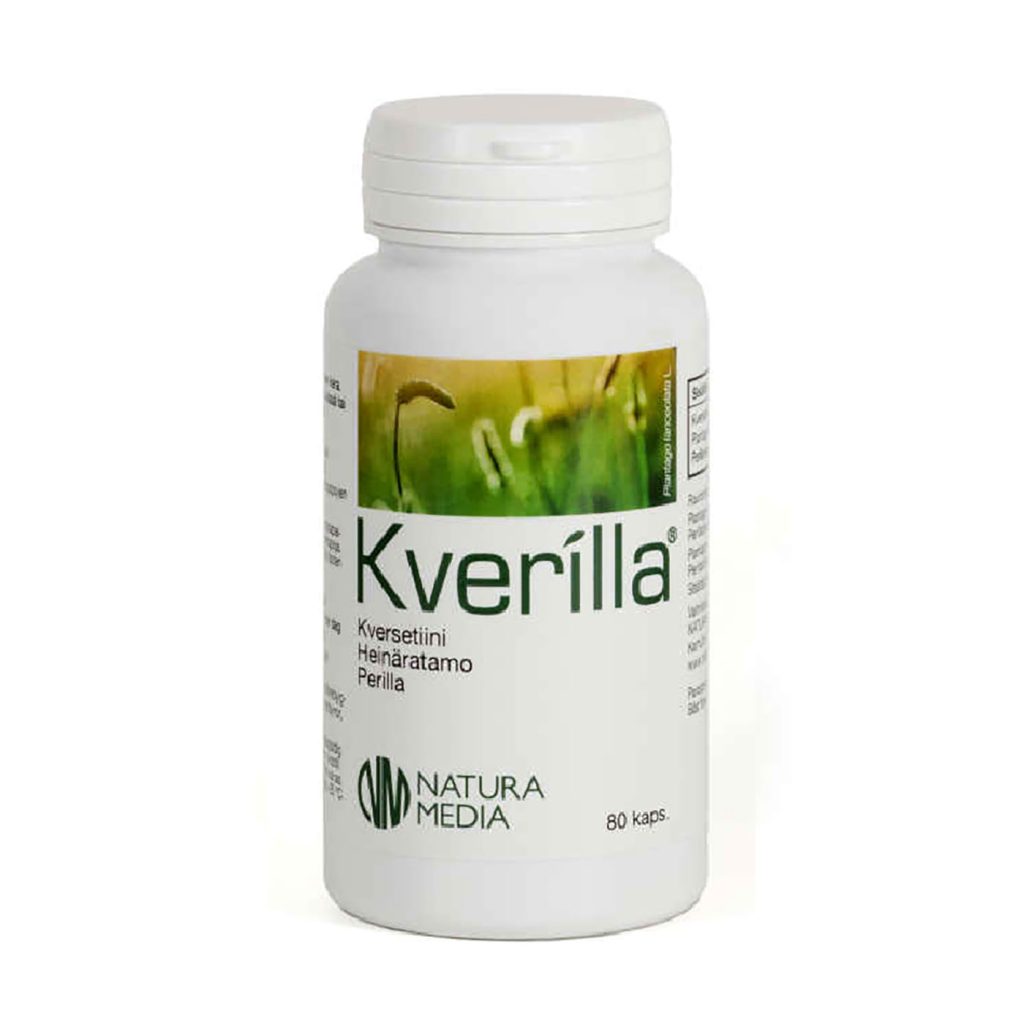Kverilla
Reduce or even reverse common allergies this summer
Kverilla contains perilla, quercetin and ryegrass.
Daily Intake
Take 1-2 caps. per day with water. For acute needs 2-4 capsules per day or two capsules twice a day.
Formula
as per 1-4 capsules a day.
Quercetin 220-880 mg
Plantago extract 220-880 mg
Perilla seed extract 110-440 mg
Hay hazard and its avoidance
Hay fever is an allergic reaction to pollen that causes symptoms such as sneezing, runny nose and itchy eyes. This allergy is common in Finland and occurs mostly from the end of July to the beginning of September.
To avoid hay fever, you can avoid being outside when the pollen concentration is high, for example on dry and windy days. You can also use a nose guard or glasses. In addition, you can wash your hair and clothes more often than usual so that pollen does not stick to them.
The raw material called perilla is harvested from the plant’s buds before it flowers, when the concentration of the desired compounds is at its highest.
Quercetin is one of the natural flavonoids and is extracted from the flowers of the Sophora japonica tree.
The natural compounds of the plant are obtained from the haystack.
Antihistamine
Antihistamines are drugs that prevent the unwanted secretion of histamine in the body, especially in allergies. Kverilla is neither an antihistamine nor a medicine.
Kverilla contains perilla, quercetin and ryegrass.
The raw material called perilla is harvested from the plant’s buds before it flowers, when the concentration of the desired compounds is at its highest.
Quercetin is one of the natural flavonoids and is extracted from the flowers of the Sophora japonica tree.
The natural compounds of the plant are obtained from the haystack.
What is special about the perilla contained in Kverilla?
Perilla is also known as blood pipe. The leaves of the plant used as raw material for this food supplement are collected before the flowering time, when the concentration of the desired compounds in the plant is at its highest.
How special is the quercetin contained in Kverilla?
Quercetin is a natural substance, a flavonoid, extracted from the flower buds of the Sophora japonica tree.
Kverilla also includes a haystack.
The leaves, which are rich in the plant’s natural desired compounds, are collected and used from the haystack.
Ingredients
Quercetin, hay extract, perilla extract, capsule (hydroxypropyl methylcellulose), anti-caking agents (magnesium salts of fatty acids and silicon oxide).
Pack size
80 caps.
Additional Information
What is the difference between hay fever and pollen allergy
Hay fever and pollen allergy are both allergic reactions to plant pollen. Hay fever is more common and causes symptoms such as sneezing, itchy and runny nose, itchy and red eyes, and breathing difficulties.
Pollen allergy, on the other hand, can cause symptoms similar to hay fever, but it can also cause asthma symptoms. A pollen allergy can also be the cause of hay fever.
There are many different treatments for pollen allergy. Allergy medicines prescribed by a doctor are usually the most effective treatment. These include, for example, antihistamines, cortisone and leukotriene blockers.
With home remedies, the symptoms of pollen allergy can be alleviated, for example, by avoiding outdoor activities during the worst pollen seasons, using protective glasses and masks when moving outside, washing hair and clothes often and keeping windows closed.
Allergy
An allergy is a harmful hypersensitivity reaction of the body, which is triggered by an allergen to which a person is sensitized.
An allergen is usually a protein. These allergen-protein substances can be found in the following substances, among others: pollen, animal dust, poisons from insect stings and food substances.
In addition to these, allergies can be caused by some chemicals and metals (e.g. nickel allergy), in which case the allergy is called contact dermatitis.
Drug allergies and even photodermatitis, i.e. sun dermatitis, which is caused by ultraviolet radiation, are also known.
An allergic symptom occurs when the body’s immune system is activated too sensitively and without a real threat and starts an inflammatory reaction against the allergen.
In the sensitization phase, before symptoms appear, the body starts producing antibodies (IgE) against the allergen. Later, when the body encounters the same allergen again, the body secretes histamine and various enzymes as a defense.
They, in turn, accelerate blood circulation and the contraction of capillaries. At the same time, typical inflammatory reactions occur in the body, such as redness, itching, swelling of mucous membranes.
In a typical hay fever, the eyes run water and you can constantly sneeze.
Hypersensitivity
On a very general level, it can be said that the difference between allergy and hypersensitivity is that in allergy the body’s immune system is always activated.
Hypersensitivity, on the other hand, is all the unnecessary reactions of the body to substances that are not dangerous in themselves.
In hypersensitivity, the immune system is not activated to produce antibodies and no IgE antibodies are found in the blood, although the symptoms are very similar to those of an allergy.
